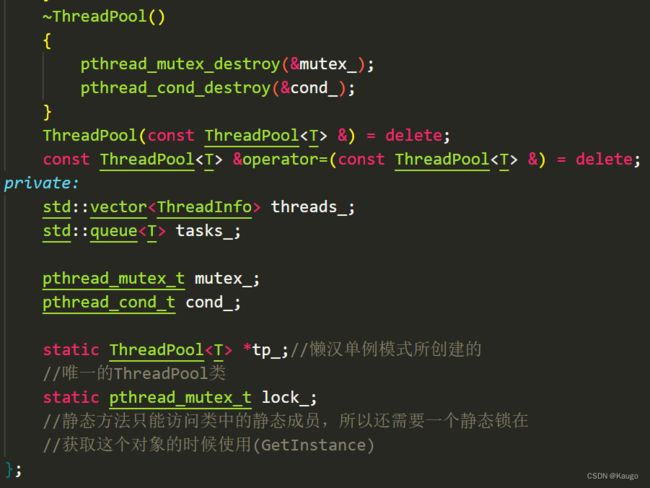【Linux】线程池的简易实现(懒汉模式)
文章目录
- 前言
- 一、懒汉方式
-
- 1.普通模式
- 1.线程安全模式
- 二、源代码
-
- 1.Task.hpp(要执行的任务)
- 2.ThreadPool.hpp(线程池)
- 3.Main.cpp
前言
`
线程池:
一种线程使用模式。线程过多会带来调度开销,进而影响缓存局部性和整体性能。而线程池维护着多个线程,等待着监督管理者分配可并发执行的任务。这避免了在处理短时间任务时创建与销毁线程的代价。线程池不仅能够保证内核的充分利用,还能防止过分调度。可用线程数量应该取决于可用的并发处理器、处理器内核、内存、网络sockets等的数量。
- 线程池的应用场景:
- 需要大量的线程来完成任务,且完成任务的时间比较短。 WEB服务器完成网页请求这样的任务,使用线程池技 术是非常合适的。因为单个任务小,而任务数量巨大,你可以想象一个热门网站的点击次数。 但对于长时间的任务,比如一个 Telnet连接请求,线程池的优点就不明显了。因为Telnet会话时间比线程的创建时间大多了。
- 对性能要求苛刻的应用,比如要求服务器迅速响应客户请求。
- 接受突发性的大量请求,但不至于使服务器因此产生大量线程的应用。突发性大量客户请求,在没有线程池情 况下,将产生大量线程,虽然理论上大部分操作系统线程数目最大值不是问题,短时间内产生大量线程可能使内存到达极限, 出现错误.
一、懒汉方式
1.普通模式
懒汉方式实现单例模式
template <typename T>
class Singleton {
static T* inst;
public:
static T* GetInstance() {
if (inst == NULL) {
inst = new T();
}
return inst;
}
};
1.线程安全模式
存在一个严重的问题, 线程不安全.
第一次调用 GetInstance 的时候, 如果两个线程同时调用, 可能会创建出两份 T 对象的实例.
但是后续再次调用, 就没有问题了.
// 懒汉模式, 线程安全
template <typename T>
class Singleton {
volatile static T* inst; // 需要设置 volatile 关键字, 否则可能被编译器优化.
static std::mutex lock;
public:
static T* GetInstance() {
if (inst == NULL) { // 双重判定空指针, 降低锁冲突的概率, 提高性能.
lock.lock(); // 使用互斥锁, 保证多线程情况下也只调用一次 new.
if (inst == NULL) {
inst = new T();
}
lock.unlock();
}
return inst;
}
};
注意事项:
1. 加锁解锁的位置
2. 双重 if 判定, 避免不必要的锁竞争
3. volatile关键字防止过度优化
二、源代码
1.Task.hpp(要执行的任务)
可根据自己的需求修改要执行的任务,这里我们以进行两个数的加减乘除为例子
#pragma once
#include 2.ThreadPool.hpp(线程池)
#pragma once
#include 3.Main.cpp
#include 